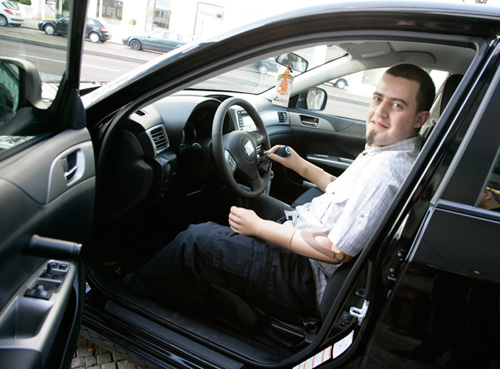Drive with a mind-controlled robotic arm!
A mind-controlled robotic arm is bringing new independence to an Austrian man who lost his arms, even allowing him to drive a car!
Christian Kandlbauer passed his driving test "with flying colors" using a mind-controlled arm prosthesis.
Created by the German firm Otto Bock HealthCare, the arm has allowed 23-year-old Christian Kandlbauer to pass a driving test, giving him the freedom to drive the seven kilometers to and from work each day without assistance.
The device is the first mind-controlled arm prosthesis in Europe. After a high-voltage electrical accident struck Kandlbauer back in 2005, both his arms had to be amputated.
His right arm has since been replaced by a myoelectric DynamicArm, which now operates the steering wheel when he drives his specially equipped Subaru Impreza, modified for him.
Taking the place of his left arm, however, is the new, seven-jointed prosthetic arm, which he controls in real time using just his thoughts. He now operates that arm to control the direction indicator lights, horn and all other safety-related devices of his vehicle.
The prosthesis is based on targeted muscle reinnervation (TMR), a process by which four key arm nerves are systematically relocated to the surgically segmented chest musculature. Once reinnervation is complete -- it can take several months -- the surface of the chest forms an interface to the patient's brain.
For Kandlbauer, who works in a garage, it's been a dream come true. He obtained his driver's license in October and has been traveling back and forth to work in his own vehicle ever since.
It's not clear whether it's truly a case of "mind-control," however, "particularly because other researchers have been working -- with much less success -- on reading out command signals directly from the brain, where the term seems more appropriate," told Gerald Loeb, professor of biomedical engineering at the University of Southern California.
Nevertheless, TMR is "an important extension of the original concept of myoelectric control because it enables users to operate multiple degrees of freedom in a way that is much more natural and intuitive than has been possible before," he explained.
"That sort of command capability is essential to take advantage of the much more sophisticated mechatronic hands and arms that are being developed by several research and commercial groups, including Otto Bock," Loeb added.
Currently, however, the prosthesis with sensory perception is only a prototype. It will likely take another four years of development before Kandlbauer can use it on a day-to-day basis, Otto Bock said.
Christian Kandlbauer passed his driving test "with flying colors" using a mind-controlled arm prosthesis.
Created by the German firm Otto Bock HealthCare, the arm has allowed 23-year-old Christian Kandlbauer to pass a driving test, giving him the freedom to drive the seven kilometers to and from work each day without assistance.
The device is the first mind-controlled arm prosthesis in Europe. After a high-voltage electrical accident struck Kandlbauer back in 2005, both his arms had to be amputated.
His right arm has since been replaced by a myoelectric DynamicArm, which now operates the steering wheel when he drives his specially equipped Subaru Impreza, modified for him.
Taking the place of his left arm, however, is the new, seven-jointed prosthetic arm, which he controls in real time using just his thoughts. He now operates that arm to control the direction indicator lights, horn and all other safety-related devices of his vehicle.
The prosthesis is based on targeted muscle reinnervation (TMR), a process by which four key arm nerves are systematically relocated to the surgically segmented chest musculature. Once reinnervation is complete -- it can take several months -- the surface of the chest forms an interface to the patient's brain.
For Kandlbauer, who works in a garage, it's been a dream come true. He obtained his driver's license in October and has been traveling back and forth to work in his own vehicle ever since.
It's not clear whether it's truly a case of "mind-control," however, "particularly because other researchers have been working -- with much less success -- on reading out command signals directly from the brain, where the term seems more appropriate," told Gerald Loeb, professor of biomedical engineering at the University of Southern California.
Nevertheless, TMR is "an important extension of the original concept of myoelectric control because it enables users to operate multiple degrees of freedom in a way that is much more natural and intuitive than has been possible before," he explained.
"That sort of command capability is essential to take advantage of the much more sophisticated mechatronic hands and arms that are being developed by several research and commercial groups, including Otto Bock," Loeb added.
Currently, however, the prosthesis with sensory perception is only a prototype. It will likely take another four years of development before Kandlbauer can use it on a day-to-day basis, Otto Bock said.
